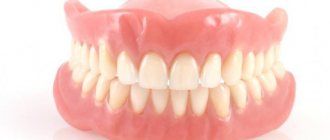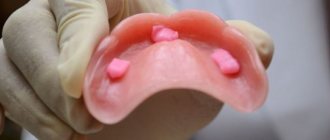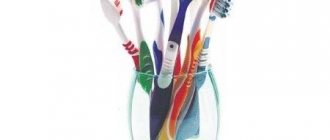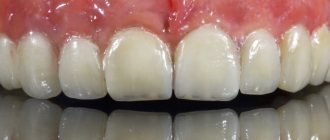If 3 teeth are missing, the patient can be helped with a removable denture, dental bridge or implantation. Implantation of implants is the preferred option: it provides high aesthetics, preservation of adjacent elements and bone tissue (bone atrophy is stopped), reliability and durability. The choice of implantation method depends on the location of the defect.
- When used:
missing 3 teeth - Type of anesthesia:
local anesthesia - Procedure time:
from 45 minutes - Treatment period:
up to 4 months - Healing period:
up to 7 days - Age restrictions:
from 18 years old
What is better if 3 teeth are missing - dentures or implants?
Let's look at possible recovery methods:
- Bridge prosthesis
A fixed structure consisting of several crowns is fixed to adjacent teeth with a special dental adhesive-cement. Before installing the prosthesis, the supporting units are depulped and ground. If there are no last teeth in the row, it will not be possible to install such a prosthesis, since there is no support.
- Removable denture
A structure consisting of artificial gums with soldered crowns, fixed on the gums, held by hooks to adjacent teeth. Prosthetics do not require filing or removing the nerve of nearby supporting teeth. But such fastening is unreliable; food particles get under the prosthesis.
- Implantation
In the absence of several elements, individual implants (titanium roots) are implanted into the “free” places, which are loaded with a fixed prosthesis on the 2-3rd day (with a one-stage protocol) or after the implants have healed (with classical implantation).
Implantation is the best way, as it provides:
- safety of neighboring teeth - they do not need to be depulped and ground down;
- aesthetic result - artificial teeth on implants are difficult to distinguish from natural ones;
- bone preservation - with an implant, the bone tissue experiences stress and does not decrease in size;
- reliability, durability - implants can withstand significant chewing loads and last 30 years or more with proper care.
Prosthetics of molars at the ILATAN clinic
Modern dentistry offers many durable solutions that provide maximum patient comfort while at the same time providing excellent aesthetic, functional and therapeutic results. When choosing a prosthetic restoration, we take into account the patient's existing conditions and expectations. By scheduling a free consultation with an orthopedist or implantologist at any of the ILATAN family dentistries by phone, you will find out which dental restoration option is right for you and can take advantage of high-quality dental services at affordable prices.
Implantation methods
- Classical
operation is carried out in two stages. A two-part artificial root is implanted (the implant and abutment are separate elements) by detaching the gum flap and suturing it into the bone. After 2-6 months, the gums are opened, and abutments are fixed to the implants. The implants are loaded with metal-ceramic or zirconium crowns. Until the titanium roots engraft, the patient wears a temporary removable denture. In case of bone deficiency, implantation is preceded by bone grafting (bone augmentation surgery).
1
Implantation
Implantation of 3 implants
Installation of a butterfly prosthesis or temporary crown (if it is possible to remove the bite)
4-6 months
2
Prosthetics
Installation of abutment and permanent crown
- One-stage
Monoblock implants are implanted (abutments and implants are inseparable) without detachment of the gingival flap - through a puncture in the gum. It is possible to install an implant in the socket of a newly removed unit. On days 2-3 after surgery, an adaptation prosthesis (with a titanium arch and plastic crowns) is fixed. After the artificial roots have engrafted, the temporary structures are replaced with permanent ones (with metal-ceramic or zirconium crowns). In a one-stage operation, implants are implanted into deep layers of bone that are not subject to resorption—bone grafting is not performed.
1
Implantation
Implantation of 3 implants
2 - 3 days
2
Prosthetics
Fixation of an adaptive prosthesis with a titanium arch and metal-plastic crowns
in a year
Permanent prosthetics
The choice of method for implanting three teeth in a row is determined after diagnosis and depends on the location of the defect (front or chewing teeth) and its extent.
Price
The clinic uses a case payment system. The cases are designed for installation of 1 implant. Accordingly, if two teeth are missing, the package cost will double.
The cost of the surgical stage includes:
- anesthesia;
- implant;
- plug, abutment, former;
- complex of reconstruction and basic bone augmentation;
- repeat CT.
The price of implants varies depending on the type of bone. Nobel Biocare PMC (cheaper) is intended for weak bones, and Nobel Biocare Conical Parallel CC (more expensive) is for dense bone tissue.
The cost of prosthetics includes:
- making a crown;
- taking impressions;
- installation.
Paid separately:
- tooth extraction with one-stage implantation - the price depends on the complexity (simple is cheaper, complex is more expensive);
- bone grafting or sinus lifting if necessary - the price depends on the amount of bone material and the method of osteoplasty.
How many implants are needed?
Possible options:
- 2 classic (two-piece) implants are implanted along the edges of the defect, after healing they are loaded with a permanent prosthesis of 3 connected crowns (2 “sit” on the implants at the edges, 1 in the middle fills the void);
- 3 classic (two-piece) implants replace missing teeth with individual implants and load them with separate crowns after implantation of artificial roots;
- 3-4 monoblock (one-stage) implants on titanium roots immediately fix an adaptive prosthesis with a titanium arch and three welded crowns.
The choice of the number of implants depends on the location of the defect.
Causes of edentia
The first cause of adentia is periodontitis.
The second cause of edentia is caries.
The third reason for tooth loss is pulpitis
The fourth cause of adentia is periodontitis.
The fifth possible cause of adentia is hypoplasia
The most common thing is the lack of proper oral hygiene and care.
There are three diseases that provoke tooth loss - periodontitis (soft tissue diseases), caries and its complications (pulpitis and periodontitis) and hypoplasia (underdevelopment of tooth tissue, most often enamel).
There are other reasons for tooth loss - due to a blow or some complex disease - but such cases are exceptions to general practice, so we will not dwell on them in detail.
The main reason leading to tooth loss is, after all, a lack of proper attention to one’s health and letting the first signs of illness take their course.
There is no consensus or single way to prevent caries or periodontitis; the occurrence of these diseases can be influenced by various factors - genetic predisposition, poor nutrition, poor hygiene and even the area of residence. But timely diagnosis and proper treatment always save the patient from many further health problems.
Features and options depending on the location of the defect
Upper jaw
The jaw bone on top has a loose structure - more implants are required, and they take 1-2 months longer to take root than in the lower jaw. The bone tissue on top is smaller in height; after the loss of an element, it quickly atrophies. In addition, the maxillary sinuses are located close to the upper jaw, so implantation should be carried out with extreme caution.
When choosing a classic protocol for bone deficiency, bone grafting (sinus lift) and installation of 2-3 classical implants are required. As part of a one-stage protocol, 3-4 one-piece implants are implanted, eliminating bone grafting and shortening the treatment period.
Lower jaw
The bone tissue of the lower jaw has a less loose structure; implants take root here faster. The bone is not as susceptible to atrophy as the upper one, but with a long absence of teeth, the likelihood of active tissue destruction is high. In addition, surgery on the lower jaw is complicated by the proximity of the mandibular nerve, which is taken into account after a CT scan.
Installing three implants using a one-stage protocol is the best option for the lower jaw. Instant installation of an orthopedic structure allows you to speed up the healing of implants and reduce the number of dietary restrictions.
Front teeth
If three or more teeth are lost in the frontal area, 3 classic implants are installed, after which they are healed, single crowns are placed. The method helps to achieve a highly aesthetic result (artificial units look natural, an even gum contour is formed). In case of bone deficiency, bone grafting is performed.
It is not always possible to implant 3 monoblock implants within the framework of a one-stage protocol on the front teeth: an extended defect is needed to fix the products, and the frontal units are usually small in size. The fact is that titanium roots are installed at an angle (to avoid bone tissue buildup) - the roots of neighboring elements can be touched.
Chewing teeth
It is preferable to install monoblock implants (3-4 pieces) in place of 3 missing chewing teeth. Titanium roots are implanted at an angle into areas of “quality” bone, bypassing the roots of neighboring units. The implants are immediately loaded with a prosthesis consisting of 3 crowns.
You can install 3 classic implants, but the teeth in the chewing area are most subject to stress, and the likelihood of bone atrophy is high. When choosing a classical technique, bone tissue will need to be augmented before implantation.
Advantages and disadvantages
The advantages of the product include the following factors:
- The ability to fully restore a defect in the dentition;
- Good fixation;
- Natural appearance;
- Invisibility to others;
- Sufficient strength;
- Fast manufacturing process;
- Low cost;
- Possibility of use in the presence of gum disease;
- Hypoallergenic and safe material of manufacture;
- Can be used as a temporary or permanent structure;
- Prevents bone tissue atrophy;
- Correctly distributes the chewing load throughout the jaw;
- Possibility to install a prosthesis immediately after removal;
- The design is easy to take off and put on;
- Simple hygienic care.
The disadvantages of the butterfly include the risk of chipping or breaking the product, since plastic or nylon are not very durable. The disadvantage is that it is fixed using clasps, which can weaken over time and if the pressure is too much, the prosthesis will simply fall off. Compared to other materials (ceramics, zirconium dioxide), plastic structures do not look aesthetically pleasing or natural enough.
We can conclude that the butterfly prosthesis is a good design and, given its cost, the advantages far outweigh the disadvantages.
Operation stages
1. Consultation
The doctor listens to the patient, determines the condition of the teeth, gums and the advisability of implantation, and answers the patient’s questions.
2. Diagnostics
The patient is sent for an x-ray. A 3D computed tomography (CT) scan is performed. Helps to exclude contraindications and assess the volume and condition of bone tissue.
3. Preparation
They organize treatment of dental pathologies (if they are diagnosed), and carry out professional cleaning of the oral cavity.
4. Installation of implants
After anesthesia, the implants are implanted using the method of detaching the gum flap, followed by suturing the gums (with a two-stage protocol) or fixed through a puncture (with a one-stage implantation).
5. Prosthetics
If the operation is organized in 2 stages, 2-6 months after the implantation of titanium roots, the patient is fitted with permanent dentures with crowns made of zirconium dioxide or metal ceramics. While the bone is fused with the implants, the patient wears a temporary removable denture. In a one-stage protocol, the installed artificial roots are loaded with an adaptive prosthesis 2-3 days after surgery. Re-prosthetics with permanent structures are organized after a year.
Indications and contraindications for production
A butterfly denture is made in the following clinical situations:
- Loss of 1-3 teeth in the front or side of the jaw;
- The need for prosthetics for 2-3 teeth;
- Partial edentia;
- Absence of a tooth by nature;
- Temporary replacement of a defect during the manufacture of a permanent structure;
- Inability to perform prosthetics using other prostheses;
- Presence of contraindications to implantation;
- Patient's wishes.
Contraindications to prosthetics are:
- Absence of more than 3 teeth in a row;
- Severe tissue atrophy;
- Periodontal diseases of adjacent teeth;
- Stomatitis, acute inflammatory processes in the oral cavity;
- Allergy to manufacturing materials (plastic, nylon);
- Deformation or defect of the alveolar process;
- Removal of the last molars, since their replacement is impractical.
Complications
Adentia leads to a variety of physical and aesthetic complications:
- in the area where a tooth is missing, the unloaded bone gradually atrophies;
- the face may become asymmetrical, lip closure is disrupted, and the chin and nasolabial folds deepen. Often the position of the corners of the mouth changes, they begin to sink;
- underdevelopment of the jaws occurs. It is expressed more strongly the more teeth are missing, various dentofacial deformations appear;
- with multiple edentia of the lower jaw, its strong protrusion and deep bite are observed;
- with anomalies of the upper jaw, the lower dentition begins to overlap the upper one;
Underdevelopment of the jaws is not observed in all cases, and not all children and adults express it in the same way. However, in all cases, edentia leads to negative changes in appearance.
With complete or multiple edentia, the bite is formed incorrectly and the function of oral digestion is disrupted. The food is poorly crushed, and the patient is forced to give up many tasty dishes. We should not forget that with this pathology a person’s self-esteem decreases, he begins to worry about the fact that he looks unattractive, withdraws into himself and is less likely to make contact with people.











